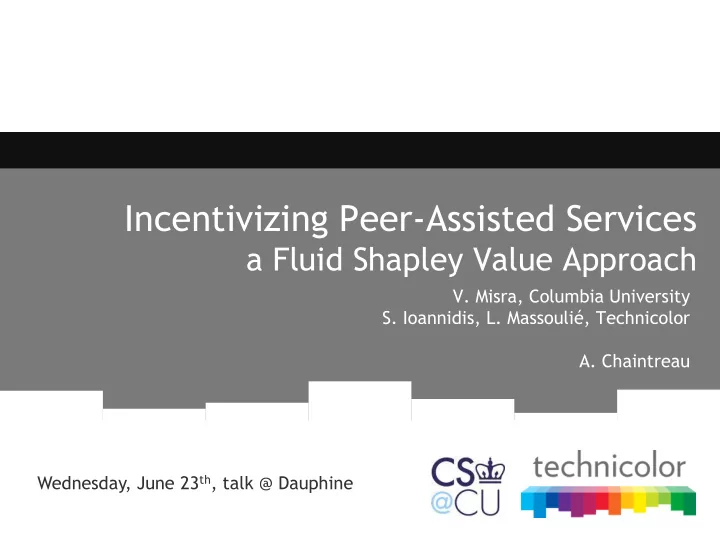

Incentivizing Peer-Assisted Services a Fluid Shapley Value Approach V. Misra, Columbia University S. Ioannidis, L. Massoulié, Technicolor A. Chaintreau Wednesday, June 23 th , talk @ Dauphine
Structure of this talk Motivation Requirements for incentivizing peer-assistance A Fluid-Atomic Shapley approach Applications Concluding remarks 2
Peer-to-Peer (P2P) is a double edged sword P2P is technically beneficial … Self-Scaling, Resilient, Versatile … but it puts Internet economy under stress Content right owners see a shrinking revenue Access network providers see increasing traffic Internet becomes engineering/regulatory battlefields Traffic filtering … will it work? Network neutrality … will it block innovation? 3 7/2/2010
An alternative to P2P We focus here on peer-assisted services A service offered by a provider, for a given price Some users commit their resources to assist in provision of service Address P2P via an economic rethink Allows to fight illegal content with equal arms (through added features, authentication etc.) Focus on fairness and efficiency 4 7/2/2010
Examples of peer-assisted services Content ? Server Peer-assistance enabled ? The Internet ? Residential Gateways (owned and managed by the ISP) 5 7/2/2010
Examples of peer-assisted services (cont'd) A principle found in multiple scenarios Content: broadband, mobile peer-assistance: retrieve content locally Bandwidth: wireless community, femtocell peer-assistance: make access available CPU: Crowdsourcing peer-assistance: provide computing power 6 7/2/2010
Incentivizing peer assistance Incentives have been studied in P2P for several years Focus on churn, free-riding, sybil attacks Indeed, much of P2P today relies on altruistic users Incentive is critical for peer-assisted services Deployment: users should decide to opt-in Stability: users keep control on their own resources (e.g. unplug or throttle their gateway) Provider wants to have guaranteed revenue. 7 7/2/2010
Solutions deployed today One-shot incentive to Opt-in receive a gift (free upgrade or feature) or even make you pay! Sharing common resource Restricted to a zero value economy Revenue sharing Looks more general and promising but how to tune it? 8 7/2/2010
Structure of this talk Motivation Requirements for incentivizing peer-assistance A Fluid-Atomic Shapley approach Applications Concluding remarks 9
An incentive mechanism for peer-assistance 1. Stability/Fairness loose: individually rational users do not leave tight: derived from objective fairness axioms 2. Economically efficient loose: sum of incentives matches cost reduction tight: optimality = system leads to minimum cost 3. Manage different scales Interaction of large user population and big players 4. Computationally efficient 10 7/2/2010
Cooperative Game, "Should I stay or should I go?" Coalition: Players: Value: Value: Coalitions Coalition: Value: 11 7/2/2010
Shapley Value 1. Efficiency 2. Symmetry 12 7/2/2010
Shapley Value 1. Efficiency 2. Symmetry 3. Balanced contribution Shapley value is equal to 13 7/2/2010
Structure of this talk Motivation Requirements for incentivizing peer-assistance A Fluid-Atomic Shapley approach Applications Concluding remarks 14
Incentivizing peer-assistance A new multi-class fluid-atomic approach 1 atomic player: the provider (revenue per user) Peers represented by continuous fluid in m classes. Let denote the fraction of participating peers in each class Let be the marginal service cost per user (Traditional service) (Provider is a veto player) (Peer-assisted service) 15 7/2/2010
Shapley Value Fluid limit 1. Efficiency 1. Efficiency 2. Symmetry 2. Symmetry Users in class i have 3. Balanced contribution 3. Balanced contribution Shapley value is equal to 16 7/2/2010
An intuitive proof Shapley value equals E[V(S(pi,i) U {i} ) – V(S(pi,i)] where S(pi,i) containing predecessors of i in a random "permutation" chosen uniformly Let s in [0;1] be the relative "rank" of a player i in the permutation pi. (essentially it is uniform on [0;1]) As the system becomes large By law of large numbers, S(pi,i) contains If i is not P, then S(pi,i) contains P with probability s 17 7/2/2010
More remarks The formal proof uses limit axioms Simplifies results from Aumann-Shapley74 and Hart73 Using a limit of balanced contribution Myerson77 The limit axioms offers a flexible methodolody multiple atomic players other scenarios like network neutrality cost of peer-assistance incurred by user 18 7/2/2010
Structure of this talk Motivation Requirements for incentivizing peer-assistance A Fluid-Atomic Shapley approach Applications Concluding remarks 19
Qualitative properties General conditions to achieve grand coalition Cost saving should compensate cost of sharing Provider's Shapley value always increases with X Peer's Shapley Value Combination of 2 effects Cost reduction 1. Loss of bargaining power 2. Characterized by concavity/convexity 20 7/2/2010
Quantitative properties Linear cost: Shapley value independent of X Example: VoD with peer-assistance File size ; class i upload bits; cost bwidth Cost per user becomes Shapley value: "Serve two, get one free" is fair and optimal 21 7/2/2010
Conclusion Economic rethink of peer-assistance Provides strong fairness/efficiency guarantee Flexible: interaction of peers and big players, … Computationally simple: closed form expressions Future works Can we apply this model to energy-efficient operation of (distributed) services? Can we handle competing providers? 22 7/2/2010
Thank you! R. T. B. Ma, D. Chiu, J. C. Lui, V. Misra, and D. Rubenstein. Internet Economics: The use of Shapley value for ISP settlement. Proc. ACM CoNEXT , 2007. R. T. Ma, D. Chiu, J. C. Lui, V. Misra, and D. Rubenstein. On cooperative settlement between content, transit and eyeball internet service providers. In Proc. of ACM CoNEXT , 2008. V. Misra, S. Ioannidis, A. Chaintreau, L. Massoulié, Incentivizing Peer-Assisted Services: a Fluid Shapley Value Approach. In Proc. of ACM. SIGMETRICS, 2010 23
Recommend
More recommend